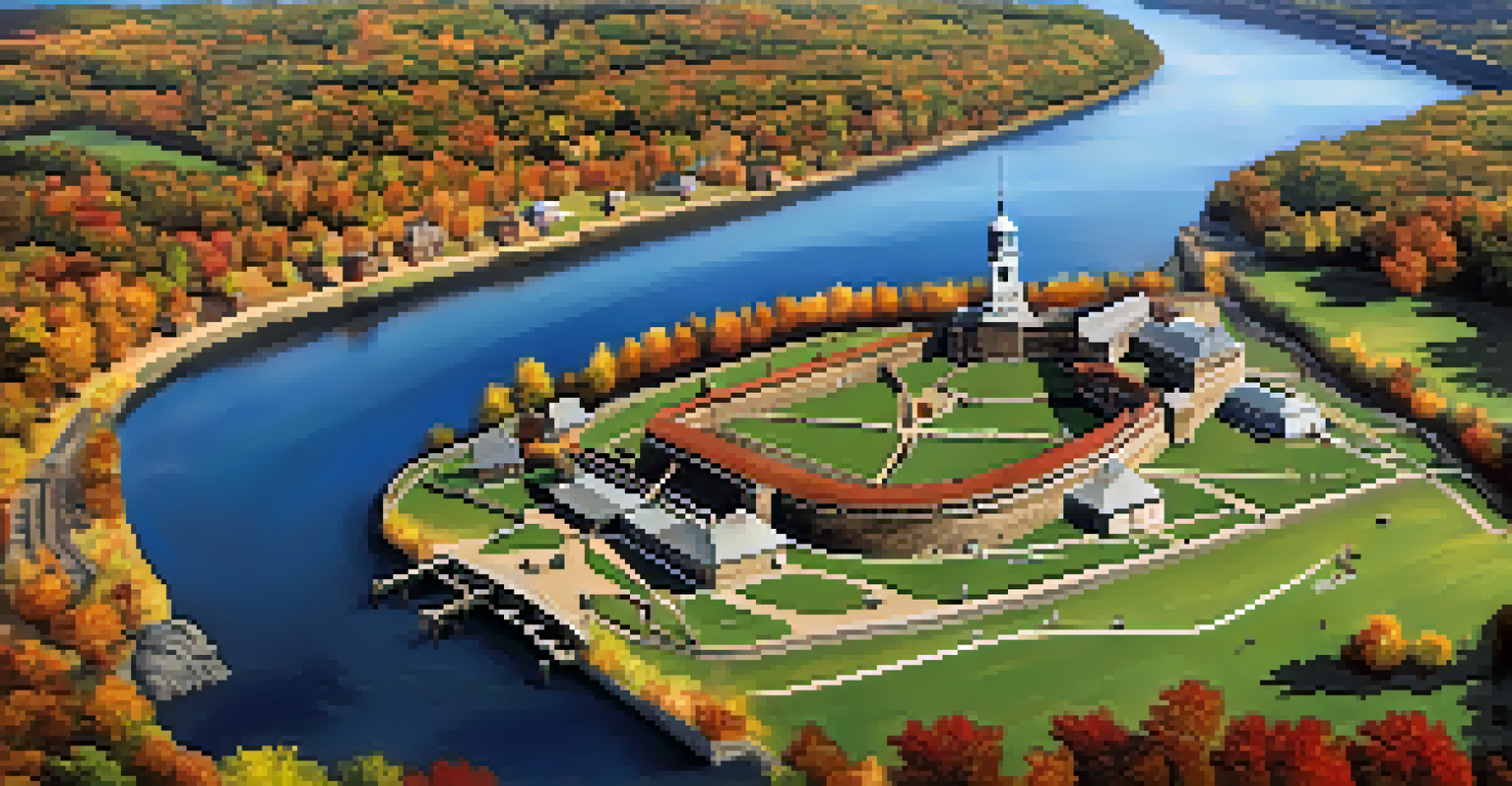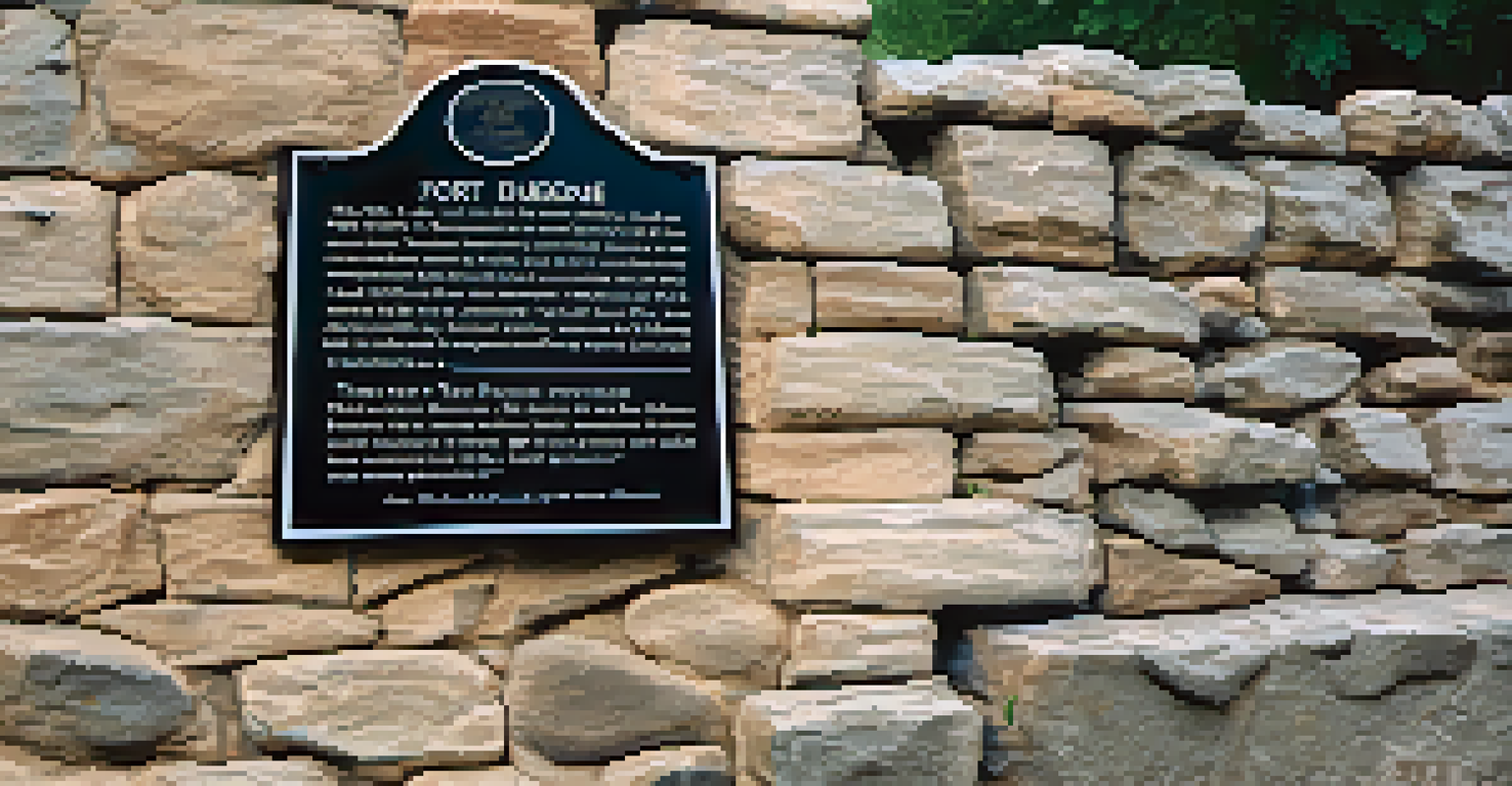Fort Duquesne: The Strategic Stronghold of Early America

Introduction to Fort Duquesne: A Historical Overview
Fort Duquesne, located at the confluence of the Allegheny and Monongahela Rivers, was a pivotal military stronghold in early American history. Established by the French in 1754, it served as a strategic point during the French and Indian War. This fortification not only represented French territorial claims but also became a focal point for British and colonial interests in the region.
Fort Duquesne was the focal point of the French and Indian War, a symbol of the struggle for control over North America.
The fort's location was vital for controlling the waterways, which served as critical transport routes for troops and supplies. Its establishment marked the beginning of intense conflict between the French and British forces, setting the stage for future confrontations. The fort's name honored the Marquis Michel de Duquesne, the Governor-General of New France, highlighting its significance to French colonial ambitions.
As the war escalated, Fort Duquesne became synonymous with the struggle for control over North America. The fort's strategic importance and the battles surrounding it played a key role in shaping the early American landscape, making it an essential subject of study for historians and enthusiasts alike.
The Strategic Importance of Fort Duquesne
The strategic location of Fort Duquesne was paramount for both the French and British forces. Nestled at the point where two major rivers meet, it controlled access to the Ohio River Valley, a region rich in resources and vital for trade. This made it a coveted asset for any colonial power looking to expand its influence in North America.

The fort's design, featuring robust walls and a commanding view of the surrounding area, allowed for effective defense against potential attacks. Additionally, it served as a base for launching military campaigns into the frontier, further establishing its military significance. Control of Fort Duquesne meant control of the surrounding territories and trade routes, which were crucial during the colonial era.
Crucial Role in French and Indian War
Fort Duquesne was a strategic military stronghold that significantly influenced the conflicts between French and British forces in North America.
The rivalry between the French and British intensified with each skirmish over Fort Duquesne, illustrating the larger struggle for dominance in North America. Each side recognized that whoever held the fort could potentially tip the balance of power, making it a focal point in their military strategies.
Key Battles Involving Fort Duquesne
Several significant battles unfolded around Fort Duquesne, shaping the course of the French and Indian War. The most notable was the Battle of Fort Duquesne in 1755, where British General Edward Braddock led an ill-fated expedition to capture the fort. This battle illustrated the challenges faced by the British forces as they attempted to engage in traditional European warfare against a more guerrilla-style fighting by the French and their Native American allies.
The importance of Fort Duquesne cannot be overstated; it was a key to the Ohio River Valley and a battleground for future powers.
Despite their initial numerical superiority, the British suffered a devastating defeat, which underscored the fort's formidable defenses and the effectiveness of the French military strategy. This loss not only bolstered French morale but also delayed British plans for westward expansion, leading to further confrontations in the years that followed.
The battles surrounding Fort Duquesne were not merely military engagements but also pivotal moments that influenced colonial alliances and strategies. These conflicts highlighted the complexities of warfare during this period and set the stage for future territorial disputes between the emerging American colonies and European powers.
The Fall of Fort Duquesne
The fate of Fort Duquesne changed dramatically in 1758 when British forces, now better prepared and led by General John Forbes, launched a successful campaign to capture the fort. This operation involved a mix of traditional military tactics and collaboration with Native American tribes, showcasing a more unified approach among the British forces. The fort’s defenses, weakened by years of conflict and neglect, ultimately succumbed to the British assault.
Upon its capture, the British renamed Fort Duquesne to Fort Pitt, in honor of the British Prime Minister William Pitt the Elder. This renaming symbolized a shift in power and the growing influence of British interests in the region. The fall of the fort marked a turning point in the French and Indian War, leading to British dominance in the Ohio River Valley.
Transformation to Fort Pitt
The fall of Fort Duquesne to British forces in 1758 marked a major turning point in the war, leading to the fort's renaming as Fort Pitt and the expansion of British control.
The transformation of Fort Duquesne into Fort Pitt not only solidified British control but also paved the way for future settlement and expansion into the western territories. This change in ownership had lasting implications for the indigenous populations and the future of American colonization.
Cultural Significance and Legacy of Fort Duquesne
Fort Duquesne holds a significant place in American history, symbolizing the early struggles for territory and power in North America. Its legacy is evident in the way it shaped colonial relations and military strategies during the French and Indian War. The fort serves as a reminder of the complex interactions between European powers and Native American tribes during this turbulent period.
Today, the site of Fort Duquesne is recognized for its historical importance and is often included in discussions about early American military history. The fort's story is not just about battles and sieges; it reflects the broader narrative of colonization, conflict, and cultural exchange. This history resonates with many, as it highlights the diverse influences that have shaped the United States.
As a cultural landmark, Fort Duquesne continues to be a point of interest for historians and tourists alike. Its legacy lives on in the stories of those who fought, the strategies employed, and the lasting impact on the region's development, making it an integral part of America's historical tapestry.
Fort Duquesne in Popular Culture
The story of Fort Duquesne has inspired various representations in popular culture, reflecting its dramatic history and significance. Books, films, and documentaries have depicted the fort's role in the French and Indian War, often focusing on its strategic importance and the battles that took place around it. These portrayals help to engage a wider audience with this chapter of American history.
One notable example is the portrayal of Fort Duquesne in historical novels that emphasize the personal experiences of soldiers and civilians during the conflict. Through these narratives, readers gain insight into the emotions and motivations behind the military strategies employed. This storytelling approach humanizes the historical events, making them more relatable and engaging.
Legacy and Cultural Significance
Today, Fort Duquesne is recognized for its historical importance and serves as a cultural landmark that reflects the complexities of early American history.
Additionally, educational programs and reenactments at historical sites strive to bring the story of Fort Duquesne to life. These initiatives not only preserve the memory of the fort but also foster a deeper understanding of the complexities of early American history for future generations.
Visiting Fort Duquesne: Historical Sites Today
For those interested in exploring the history of Fort Duquesne, several sites now commemorate its legacy. Located within Point State Park in Pittsburgh, Pennsylvania, visitors can find markers and remnants that highlight the fort's historical significance. The park serves as a gateway to understanding the fort's role in early American history while offering beautiful views of the confluence of the rivers.
Educational programs and guided tours are available, providing insights into the fort's construction, military strategies, and the broader context of the French and Indian War. These resources make history accessible and engaging for people of all ages. By visiting, individuals can connect with the past in a meaningful way, enhancing their appreciation for the struggles that shaped the nation.

Engaging with the history of Fort Duquesne offers a unique opportunity to reflect on the complexities of early American life. Whether through onsite visits, educational materials, or community events, the legacy of Fort Duquesne continues to inspire curiosity and respect for the rich history of the United States.